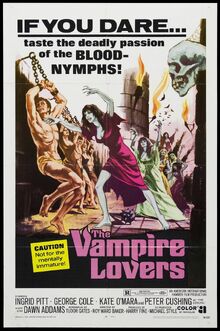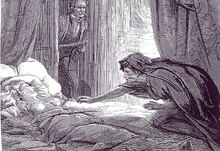
The Vampire Lovers is a 1970 film adaptation of J. Sheridan LeFanu’s 1871 novella Carmilla. The film starred Ingrid Pitt, Madeline Smith and Pippa Steel. It was directed by Roy Ward Baker. Hammer Films in Britain produced several low budget films between the 50’s and 70’s based off vampire tales. Soon people’s interest began to trail off and the company made a decision to use more attractive women in their films…topless. Which is where The Vampire Lovers come in. The title leads the audience to believe that the film will focus on a set of lovers that are vampires but this isn't the plot. The movie was originally part of three films following the Karstein family. In 2003 MGM Home Video released the film partnered with Countess Dracula. The film is also available for rental and purchase from Amazon Instant Video.
Summary []
The film is set in the 19th century and begins with the decapitation of a lovely blonde vampire. The Baron Hartog is a vampire who is avenging the death of his sister. The vampire attempts to seduce him and he kills her. The beginning of the film sets itself up to base the storyline around gore and sex. The film then jumps forward several years to a party. The party is at the home of General von Spielsdorf, who will reappear later in the film. A Countess and her lovely daughter arrive, but the Countess is quickly summoned away. Her daughter is to stay in the care of the General. The daughter goes by the name of Marcilla (this character later becomes Carmilla). Marcilla becomes very fond of the General’s niece, Laura, who is an attractive young woman. Laura begins to have nightmares of a large cat and becomes very sick, she shortly dies. After her death Marcilla flees. Throughout the film there is a mysterious man who watches the events from a distance. His role is never explained in the film.
The real plot begins when Marcilla is back with the Countess and Marcilla has now changed her name to Carmilla. Carmilla’s mother leaves her again, only this time with a man named Mr. Morton. Mr. Morton takes Carmilla to his residence and introduces her to his daughter Emma. Emma becomes the main interest of Carmilla, it is believed she actually falls in love with her. Carmilla is torn between her romantic feelings and her blood lust. Regardless of her love she still feeds from Emma and causes her to become very ill. Emma’s governess, Madame Perrodot, becomes Carmilla’s servant. She refuses to send for a doctor even though Emma has taken ill and tries to prevent others from helping. Madame Perrodot has strong feelings for Carmilla, which eventually lead to her death later in the film. Carmilla is seen in the film to feed from two men, and kill them, but her sexual interest is only for women. The men are used purely as a means of obtaining her lover.
Carmilla decides to take Emma and flee but Emma is rescued by Carl. Carl’s character is first seen in the film as the suitor for the now deceased Laura. Carmilla flees to her family’s castle. While the struggle between Carmilla and Carl is happening, The General and Baron Hartog are at Carmilla’s estate searching for her coffin. After they find it the General drives a steak into her heart then cuts off her head.
Themes []
Sexuality & Homosexuality []
LeFanu’s novella did have a sexual undertone and hinted at the idea of lesbianism. The restrictions LeFanu made to the sexuality is most likely due to the time it was written. Over time vampires have become sensual and sexual monsters in literature and other aspects of media. The Vampire Lovers does not hint towards the idea. It is pretty clear that Marcilla/Carmilla takes an interest in young women. As in most vampire texts and films, the feeding of Carmilla becomes a metaphor for sexual desires. Normally the blood sucking of vampires is done via the neck but Carmilla uses the breast which only sexualizes the act even more. While breasts are considered sexual, the act of sucking blood through the breast of a woman could also reference lactation from women who provide for children.
Predator and Prey []

In LeFanu’s original text Carmilla is a notably young women but in the 1970’s version the age gap is an obvious one. Carmilla appears to be in her 30’s where Emma seems to be in her late teens or early 20’s. Her nativity is a huge indicator of her age. Emma's wide eyed appearance, clothing selection, father relationship and soft voice only leads the viewer to see the youthfulness of the character even more. One of the first interactions between Emma and Carmilla is the changing of Emma's clothing, a still from the film is pictured to the right. The scene is Carmilla introducing Emma to a low cut and shear dress where she had previously worn modest clothing. It seems as if she has no clue that Carmilla is using her for sexual pleasure. An age gap is not uncommon in vampire texts, since vampires are immortal their age is typically much more than their prey. Part of the draw in the original Carmilla is that it was written for an audience of young girls, the relatability was the focus point. The Vampire Lover’s leans towards the idea of an older women preying on a vulnerable young girl. The age gaps reinforces the idea of Carmilla being a monster and searching for a companion in a naïve and unknowing victim.
Companionship[]
Despite Carmilla being considered a monster, her interest in Emma is one of love and companionship. Carmilla tries to balance her desires as a creature who lives on blood and her desire to feel a kinship with Emma. Throughout the film the audience sees Carmilla take interest in other young women (and sometimes men) but only for the purpose of maintaining life. Carmilla’s interest in Emma is a deeper and a more personal connection. She seeks Emma to comfort her in times of distress and shows a playful and heartfelt attitude towards her for more of the film. This idea lends itself to the love plot that almost all media is based off of. It allows the audience to feel a sense of sympathy to an otherwise heartless monster.
Importance []

While this film received mixed reviews it is a close adaptation of LeFanu’s original novella Carmilla. The adaptation stays true to the eroticism of female lovers but takes it to a modern, more vivid idea of the original story. LeFanu’s era would not have allowed for a homoerotic text to a drastic extent. Where its modern revisions it is acceptable. Even now in 2014 this adaptation isn’t considered that risqué, not compared to many other remakes. There have been several adaptations of the novella but compared to many other gothic novels it is a limited pool. The importance lies in the fact that the story continues on. The setting is still set in the Victorian era as opposed to adapting the film to a modern time or acknowledging itself as an adaptation. Other than the strange man lurking around, who the audience never learns the meaning of, there does not seem to be any other references to other vampire films. The fact that Carmilla is an adaptation or continuation of the poem Christabel by Samuel Taylor Coleridge shows the magnitude in which literature lends itself to other authors, either in the same time or years later.
